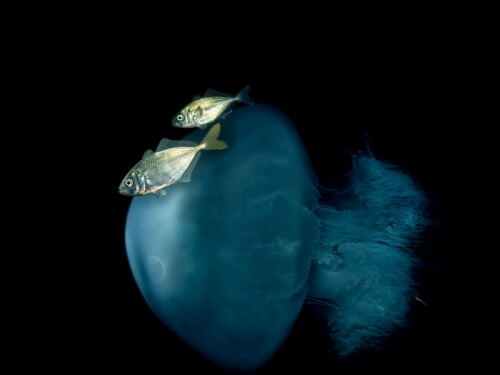Why do fish that migrate to the Mediterranean Sea have smaller eyes than their native relatives? An Israeli study conducted these days reveals that small eyes are sometimes of great importance

Article: Keren Levy
Fishermen and divers in the Mediterranean Sea have been encountering new fish in recent years that they did not know before. These are migratory fish from the Red Sea that crossed the Suez Canal in what is known as the "Lespass migration" (named after the man responsible for mining the Suez Canal, Ferdinand de Lesseps). Many studies are done on these migratory fish, and the migration process is of great interest to science as a worldwide phenomenon that affects the distribution of animals. Immigrant species that manage to survive, exist and reproduce in the new habitat may become invasive species, which compete with the native species. Indeed, many species that passed through the Suez Canal multiplied in the Mediterranean Sea, and some even reached as far as France and Spain. Some of the species that started as immigrants are already considered invasive species in the Mediterranean, and they endanger the delicate ecological balance created during millions of years of evolution.
A new study recently conducted in Israel revealed a unique phenomenon: the migratory fish that passed through the Red Sea through the Suez Canal have smaller eyes than their Mediterranean relatives. What is the secret that actually made fish with small eyes migrate to the waters of the Mediterranean Sea, and how did they take advantage of this to establish themselves in their new living environment?

big eyes
In fish, as in other animals (but not as in man), the eye grows during the entire period of growth. Therefore, the bigger the fish's body, the bigger the eye. In addition to this, there is a difference in the size of the eye between species of fish that are active during the day and fish that are active at night: a large eye allows the penetration of a lot of light and enables high visual acuity, therefore nocturnal fish have a larger eye, which allows them to see well in conditions where the lighting is weak. The large eyes are also more sensitive to light, so fish with large eyes are sensitive to glare in the light of daylight. The diurnal animals, on the other hand, are characterized by smaller eyes and less sensitivity.
Dr. Amit Lerner, head of the Laboratory for Marine Bio-Optics and Vision at the Israel Seas and Lakes Research Institute in Haifa, together with Dr. Danny Golani from the Hebrew University, examined the abundance of trawl fishing in the Mediterranean Sea and compared the eye size of the migrating fish to the local fish. The comparison was made between different species of the same family, in a wide range of body sizes. "The goal of the study was to find a connection between vision and the establishment of immigrants, and to shed light on a new aspect of the effect of vision on immigration that has not been studied so far," explains Lerner.
The blinding barrier
The comparison between the migratory fish and the local fish revealed surprising findings: in two families, the Scombridae and the Carangidae, which include species that prey on the open sea and rely mainly on vision to find their prey, the migratory fish had smaller eyes than the local species. On the other hand, in the Mullidae family, which includes species that do not rely on their sight, no difference in eye size was found between the immigrants and the local species.
How can the difference in eye size be explained? According to Lerner, the key to solving the mystery probably lies precisely in the Suez Canal itself. The canal is relatively shallow and only 25 meters deep. Because of this, it is well lit, so it is possible that fish with large eyes avoided passing through it for fear of being dazzled, while fish with small eyes passed through it without hesitation. This means that the canal created an evidentiary selection on the Lespian migration to the Mediterranean.
Things you see from there
The research findings help to explain a well-known phenomenon: the migratory species inhabit the shallower and brighter areas in the Mediterranean Sea, pushing the native species deeper. This phenomenon was documented in Golani's research and in the research of Dr. Dor Edelist and others in the past: observations of the fishing spoils testified to patterns of changing the depth axis in related fish, in which the Mediterranean species deepened its position in the water column and the migratory species settled in relatively shallow waters. Lerner, in his new study, shows that it is likely that this competition is based, among other things, on vision: the local species, which were common in the deep sea even in the past, are pushed to the depths and continue to exist there, while the migratory fish, which have the lower sensitivity to light, require stronger lighting to hunt and exist and therefore They inhabit the shallow areas. The new findings complement the existing research and contribute to the understanding of the competitiveness between species of the same family, which affects the living area.
The results of the study reveal another interesting phenomenon: the difference in eye size suggests that the migration did not happen in the larval stage, when the fish is still a small and young fry, but in the adult stage. The fish roe is carried by the current in the Suez Canal from south to north for most of the year. It has a limited ability to move, and in any case the eyes of the fry are too small to be blinded by the intensity of the light in the canal. If the passage of the kelp dictated the distribution of the migratory species in the canal, no difference in the size of the eye should have been found and the presence of migrants in the Mediterranean Sea would not have been limited to the shallow waters. The fact that the migrating fish have distinctly small eyes suggests that the fish that passed through the Suez Canal did so as mature fish, which, due to their relatively small eyes, made it through the blinding barrier. This fact is interesting in itself, and is an important and unexpected conclusion of the evidentiary study.
Lerner and Golani continue to investigate the issue, and intend to expand the study to additional fish families from among the 92 species that migrated to the Mediterranean Sea through the Suez Canal, and to compare the eye sizes of the immigrant populations of the same species found in the Mediterranean Sea with populations of their species found in the Red Sea.
For the original article on the Angle website
More of the topic in Hayadan:
- Lassepsian Immigration Office
- An invasive jellyfish has arrived from Japan and is threatening the shores of Israel

2 תגובות
If the conclusions are correct, then there is a solution to prevent the "migration" terrible lighting day and night in the shallow area.
I saw the waters of the Suez Canal, and they seemed very cloudy to me. Much more than the waters of the Mediterranean Sea (beyond the crises that raise sand clouds). In the canal you can't see even to a depth of one meter, probably all light doesn't reach the bottom. I wonder if there are measurements of lighting as a function of depth in the canal waters? Maybe I was wrong?